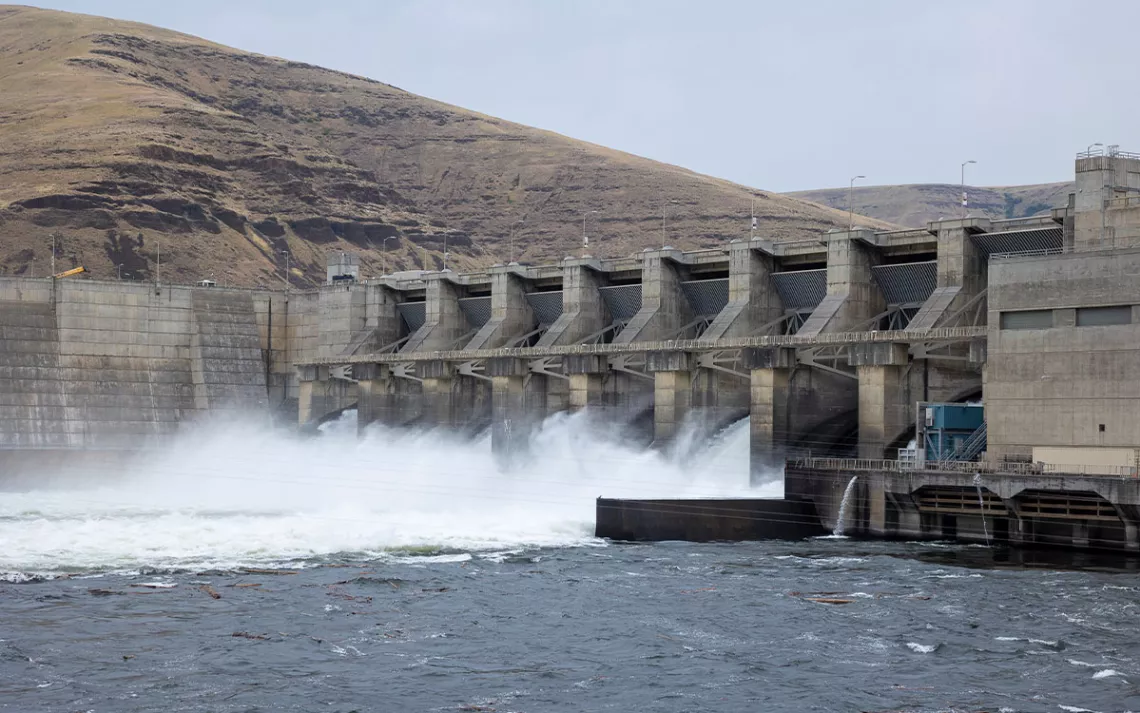Biden Administration Supports Removal of Four Dams on the Snake River
Decommissioning the dams is the first step toward restoring salmon runs and respecting Native treaties

The Lower Granite Dam on the Snake River in Washington in 2022. | Photo by Francis Chung/E&E News/POLITICO via AP Images
The Biden administration today announced its intention to move forward with the removal of four controversial dams on Washington’s Lower Snake River. The long-hoped-for dam removal is necessary to the survival of 13 endangered salmon and steelhead runs, multiple scientific reports and court cases have determined.
Native American nations and environmental groups that for decades have advocated for the dam removal applauded the White House move as an essential first step toward restoring salmon and steelhead populations.
“These dams impact not only our sustenance, but our health, our ability to interact with the land, in order to realize our treaty rights,” said Chairman Shannon Wheeler of the Nez Perce Tribes.
“The science has become increasingly clear that you aren’t going to be able to avoid extinction if you don’t breach the dams,” said Bill Arthur, the chair of the Sierra Club's Snake/Columbia River Salmon campaign.
Before the dams were constructed in the 1950s and 1960s, millions of salmon and steelhead churned up the Snake River to their spawning waters in Idaho’s Sawtooth Valley. Since then, populations have plummeted. In 1950, nearly 130,000 wild Chinook salmon made the journey up the river; in 2017, that number was less than 10,000, according to the Idaho Department of Fish and Game. During that same time period, wild steelhead declined from around 110,000 to just under 30,000.
The dams turn a 140-mile stretch of the Snake River into a series of warm, shallow reservoirs. With nowhere to hide, the salmon are vulnerable to birds and predatory invasive fish. The temperature-sensitive fish also risk overheating—when water temperatures rise above 68°F, the fish begin to die of stress and disease. In 2015, 250,000 adult salmon died in the Columbia and Snake Rivers because of warm water; just 4 percent of Snake River sockeye made it over the four Lower Snake dams, according to an analysis published by Columbia Waterkeeper. That same analysis found that without the four dams, the river would have remained cool enough for the salmon to survive.
Meanwhile, the dams themselves pose a major threat to juvenile fish migrating downstream, said Michael Garrity, an energy and water projects manager at Washington Department of Fish and Wildlife. Baby fish risk getting thrashed by turbines. “You're never going to make a dammed river as safe for juvenile salmon as a free-flowing river,” Garrity said.
For 20 years, environmental groups and tribes have fought for removal of the dams via a series of lawsuits that challenge the way salmon populations are managed. In all six cases, the courts determined that the salmon recovery plans in place violated the Endangered Species Act and were inadequate for recovery.
The recent agreement comes out of more than two years of negotiations between the Biden administration and litigants in the most recent lawsuit, which include more than 10 Native American nations led by the Nez Perce Tribe and with support from the State of Oregon.
A number of factors came together to make this decision possible now, Arthur said. A presidential administration invested in environmental protection and willing to take tribal treaty rights seriously is invaluable, he said. And replacing the power the dams produce—around 4 percent of the energy used in the Snake River region—has become more feasible as the cost of wind and solar power drops. Finally, attitudes have shifted among the public. In particular, the realization that the decline in salmon runs was negatively impacting Southern Resident orcas helped garner new public support. “A lot of times the Columbia Basin kind of looks and feels a long ways over there,” Arthur said. “The orca, for lack of a better phrase, gave us a fish in the fight.”
Removal of the Lower Snake River dams isn’t just about following the Endangered Species Act—decommissioning the dams would also honor Native treaty rights. The Treaty of 1859 between the US government and Nez Perce Tribe guarantees the tribe “exclusive taking” of fish running through or bordering its reservation—including in the Snake River and its tributaries.
“We believe that the [Biden] administration, congressional leaders, law enforcement, and the courts are all subject to the rule of law,” Wheeler said. “And the rule of law speaks to what must be done here.”
If the dam removal proceeds—the proposed agreement still must be approved by Congress—it will be at least several years before the river washes out sediment buildup behind the dams, exposing the riverbed, Garrity said. The Biden administration’s recent agreement also recommends restoration along the main stem and tributaries of the Snake River. “All those actions give the species a real shot,” Garrity said.
 The Magazine of The Sierra Club
The Magazine of The Sierra Club



